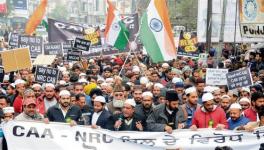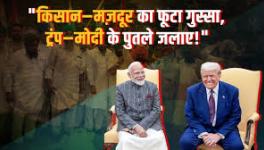The Unheard Voices In The NRC Din Speak Up

In the din surrounding Assam's National Register of Citizens (NRC), the only voice missing from the debate is that of the 'tribal' population. A recent statementby Assamese tribal intellectuals and activists makes it clear that the tribal people of Assam stand by the NRC while putting in perspective their struggles since colonial times to protect their 'commons'. This statement was signed by twelve people ranging from a trade unionist to a former member of Assam's legislative assembly and included university professors as well.
Also read: Is The Opposition Playing into the Hands of BJP on the NRC Issue?
The historical experience of the tribal people as described in the statement has beenone of struggle against a colonial state and later,a post-colonial state which still retained a lot of the features of the former. The first issues arose when 'colonial capitalism' viewed the land held in common by the 'natives' as 'wasteland'. This resulted in the colonial machinery encouraging 'industrious peasants' from Bengal to make the land productive. The tragedy was that this so called 'wasteland' was a source of sustenance for the people. This migration was also encouraged by a section of the landed high caste Assamese elite who wanted to rid themselves of the burdens that arose after the introduction of the zamindariland settlement in undivided Goalpara – a district in western Assam.
What exacerbated this situation was that the colonial state insisted on documents to prove land ownership. The absence of 'paperwork' for the land held in common enabled the colonial administration to not only appropriate the land, but to entrustit in favour of those who could make it 'productive'. The tea estates in upper Assam are a prime example of these policies.
When a tribal middle class began to emerge in Assam, their issues got politicised. This led to the creation of theAll Assam Tribal League,among other bodies,that lobbied for the rights of the people they represented. They first demanded an inner line system, then later the Tribal Belts/Blocks to contain encroachment. However, these 'safeguards' failed to contain encroachment. The statement,however, clarified that “We cannot call them illegal immigrants at that point since Bengal constituted a part of British India.”
The statement then described what the post-colonial history of the subcontinent had in store for the tribal people of Assam:
“The situation got further compounded with waves of migration of refugees from East Pakistan which reached a mammoth proportion between partition of India in 1947 and formation of Bangladesh in 1971. The decision of Government of India to settle refugees in Assam was in spite of the fact that the government’s own survey conducted in 1956 showed that there were 12,00,000 absolutely landless indigenous peasants. However, while other regions of India didn’t see large scale migration except for the immediate aftermath of the partition, continued migration, to varying degrees, into Assam even after creation of Bangladesh is a reality that cannot be wished away.”
Also read: NRC Being Used As A Tool to Create Binary of Hindu Vs Muslims?
Coming to the present situation, they have highlighted that the 40 lakh people whose names did not feature in the final draft of the NE did not consist only of people of Bengali origin. The Bengali speakers of Assam have been projected as a minority in the state, and the Bengali Hindu population constitutes 29 percent of the state's population. In numerical terms, their population is around 91 lakh. Thedata compiled bythePratidin Times,and reported by Sangeeta Barooah Pisharoty in The Wireshowsthat the predominantly Bengali speaking Barak Valley districts of Hailakandi and Karimganj had NRC rejection rates of 9.3 and 8.4 percent respectively. Cachar which is one of the major 'melting-pot' districts of Assam had a rejection rate of 12.5 percent. Cachar's rejection rate was marginally better than Tinsukia, an Ahom stronghold, which had a rejection rate of 13.2 percent. The tribal dominated Dima Hasao and Baksa districts had rejection rates of 16 and 15.4 percent respectively. What this shows is that the allegations of a 'communal agenda' on the part of the officials – whether on the lines of religion or language – seem to be misplaced.
Also read: Assam: The Mythology of “Immigrants”
The statement ended by lamenting;
“It is clear that there are no ways people can be deported, especially since there are no negotiations which have happened between Bangladesh and India regarding this issue. The state, the government in power, must work constructively towards bringing a closure to the issue, rather than attempting to reap political mileage by claiming to resolve a decades old issue.
When it is clear that there are no ways people can be deported, then people in Assam should have an informed opinion about it rather than indignation. The Indian government has initiated this process of updating the NRC,yet,without considering the situation ‘what after NRC’. Neither deportation nor detention camps can be seen as methods of resolution. So, we appeal to all concerned people of Assam, the country and the world to recognise the peculiar predicament of Assam, all its people by trying to arrive at ways in which justice prevails with a regard for its history.”
Also read: Threat of Being Rendered Stateless After Serving the Very State
The Trinamool Congress (TMC) delegation that had a rather eventful reception at Silchar airport has even been slammedby Pradip Dutta Roy, founder-president of the All Cachar Karimganj Hailakandi Students’Organisation, whohas been lobbying for the Barak Valley's separation from Assam. Roy labelled the TMC delegation's motives as an attempt to disturb the peace in Assam.
Bureaucratic error is the likely culprit for names being left out, whether the error originated during the 1951 census or in the present enumeration is debatable. However, it is undeniable that the grand figures quoted by the sangh and their affiliates – whether among the Assamese people or not – will never be unearthed. The sangh had alleged that the number of 'illegal immigrants' in Assam numbered 80 lakhs. With 40 lakh people not on the final draft – which includes people from all communities – the number is likely to reduce by the time the final NRC is published.
The people of Assam have displayed great maturity on a highly emotive issue that finds its roots in the subcontinent's colonial history. This issue has seen the state plunged into chaos at various points of its post-colonial history. Whether the politicians, 'experts' and the international human rights organisations can do the same is a different matter altogether. On the other hand, once the issue of immigration is put to rest, the politicians may run out of election ideas.
Get the latest reports & analysis with people's perspective on Protests, movements & deep analytical videos, discussions of the current affairs in your Telegram app. Subscribe to NewsClick's Telegram channel & get Real-Time updates on stories, as they get published on our website.
























